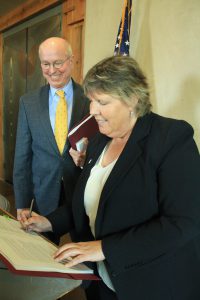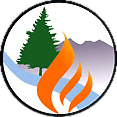
City of Flagstaff Mayor Jerry Nabours looks on as Laura Jo West, Coconino National Forest Supervisor, signs the final Record of Decision for the project’s Environmental Impact Statement
Flagstaff, AZ – On October 22, the Flagstaff Watershed Protection Project reached another significant milestone when Coconino National Forest Supervisor Laura Jo West signed the final Record of Decision for the project’s Environmental Impact Statement. A Signing Ceremony was held for partners and collaborators to celebrate this achievement. This project is unique in its origin and funding, as it was proposed by the City and is funded by a municipal bond approved by voters in 2012.
– Read to the end for information on what to expect for implementation –
Since 2013, implementation of fuels reduction treatments have been completed and will continue in areas within FWPP boundaries on City and State lands, as well as National Forest lands that were approved through previous National Environmental Policy Act (NEPA) analyses. This final Record of Decision approves treatments on the remainder of the National Forest lands within the FWPP boundary – the majority of the project area – including use of novel harvesting methods to reduce hazardous fuels on the steep slopes above Flagstaff’s key watersheds.
The Decision includes treatment of 8,669 acres through a combination of mechanical thinning, hand thinning, and prescribed burning. Prescribed fire will occur on all 8,669 acres, which includes approximately 870 acres that will receive only fire treatments. Traditional, ground-based harvesting equipment will be used for the most of the thinning (5,817 acres). Helicopter and cable logging will occur on small portions of the project area (566 and 414 acres respectively). These treatments will begin next year. Prep work – including marking trees, improving roads, and preparing contracts – will begin this fall and winter in the Dry Lake Hills area.
“This is a monumental occasion of which the entire community should be proud,” says Laura Jo West, Coconino National Forest Supervisor. “We’re at this point today because of the incredible collaboration among all the partners and the tremendous support we’ve received from the community. We got here together, and we’re excited to continue working together in the next chapter of this exceptional project.”
Though prep work is less noticeable than harvesting, the public should still expect to see increased activity in the forest over the next several months.
- Crews will be marking trees this fall and winter in the Dry Lake Hills area in preparation for implementing Phase 1 of the project next summer.
- Trees painted with orange indicate these trees are “leave trees” and will not be not cut; however, in some areas blue paint may be used to indicate trees that will be removed. Efforts will be made to minimize markings within viewsheds of roads, trails, and recreation sites.
- Thinning efforts on City, State, and National Forest lands will continue throughout the project area. This includes small-scale demonstrations of equipment on steep slopes and harvesting in the 891-acre Orion Task Order which is within the FWPP and will be carried-out through the Four Forest Restoration Initiative Phase One Stewardship Contract held by Good Earth Power, LLC.
- Smoke from prescribed fires will be noticeable from the Flagstaff area. The Coconino NF provides notifications of Forest Service prescribed fires, which can be found on the forest website at coconinonationalforest.us.
The Forest Service and City of Flagstaff developed an implementation plan that outlines the general timeline for FWPP treatments to occur. It separates thinning into three phases to maximize efficiency while limiting impacts to aesthetics, recreation, and threatened and endangered species.
- Thinning Phase 1: 1,428 acres. This phase will include treatments on the lower slopes of the Dry Lake Hills north of Flagstaff. Ground-based mechanical harvesting methods will be used. Prep work in these areas will occur this fall and winter, with harvesting expected to begin in 2016.
- Thinning Phase 2: 3,810 acres. This phase will occur on the steep slopes of the Dry Lake Hills and includes treatments that require specialized equipment such as helicopter and cable logging and steep-slope harvesting equipment. Phase 2 also includes thinning in Mexican spotted owl Protected Activity Centers (PACs) and northern goshawk post-fledging family areas (PFAs), and will be completed in as short a timeframe as possible to limit the duration of impacts. Prep work is expected to occur in 2016 and 2017, with harvesting estimated to begin in 2017 or 2018.
- Thinning Phase 3: 2,975 acres. This phase covers all the treatments in the Mormon Mountain portion of the FWPP, south of Flagstaff near Lake Mary. Prep work is planned to occur in 2017 and 2018, with harvesting activities expected to begin in 2019.
- Prescribed fire treatments will occur as conditions allow, typically in the fall and spring.
The City of Flagstaff, the USDA Forest Service, and the State of Arizona continue to make FWPP a top priority and will continue to provide the public with updates on the project that Flagstaff voters approved.
The Implementation Plan, EIS, and Record of Decision are available on the Forest Service project website at click here


